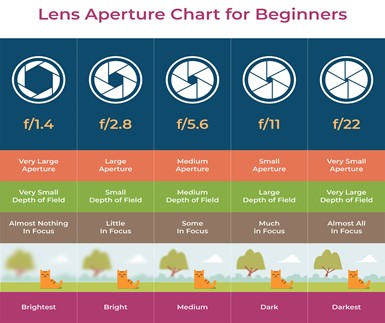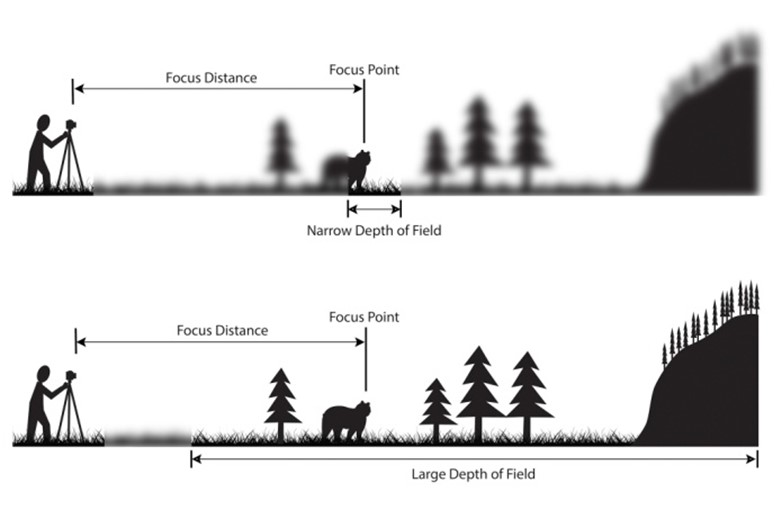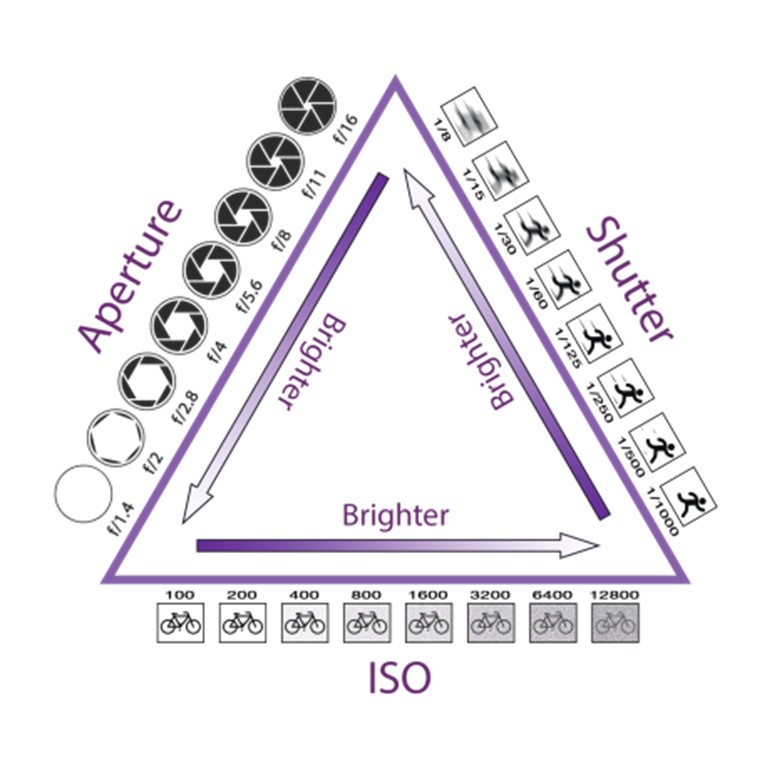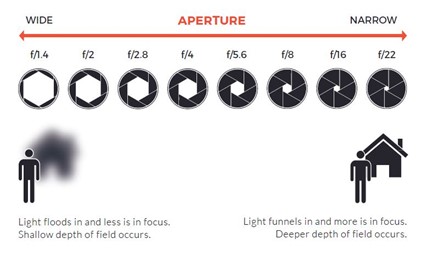Content begins here
Contenido de la página principal
Pulsa para colapsar
Aperture
In this lesson, we will learn:
1. What Aperture is.
2. Relation between Aperture and Depth of Field.
3. How to choose the perfect Aperture
WHAT APERTURE IS
In simple words, aperture is a hole in the lens that gets bigger and smaller, letting more or less light. Actually it’s very similar to the pupil of our eye. When it’s a bright day your pupil shuts up so that it lets in less light, but when it’s a dark day the pupil opens up to let in more light. An aperture works in a pretty similar way. Aperture is part of the exposure triangle (Aperture – ISO – Shutter). It is shown with the letter f in your camera, which stands for Focal Length.
APERTURE AND DEPTH OF FIELD
The Aperture controls what is called Depth of Field. Next figure shows the relation between both: the larger the aperture the smaller the depth of field, so you get the brigthest picture but almost nothing is in focus.

Image Copyright © PhotographyLife
WHAT IS THE DEPTH OF FIELD?
The Depth of Field is the distance around a focus point that is sharp. It’s the distance from the nearest object in focus to the furthest object in focus within your frame. When changing the objectives or the focus point, we will be constantly changing the depth of field.

Image Copyright © PhotographyLife
HOW APERTURE AFFECTS THE DEPTH OF FIELD
The wider the aperture, the shallower the Depth of Field. That means that not much area around the focus point will be sharp; and the smaller the aperture the larger depth of field, so a lot of distance around the focus point is sharp.
HOW TO CHOOSE THE PERFECT APERTURE
As we said before, the aperture is part of the exposure triangle. That’s why, the amount of light that enters the lens hitting the camera sensor is important. Changing the aperture, the ISO and the Shutter speed are affected as well. So to choose the right Aperture for your shot means to take into consideration the whole exposure triangle. For example: if you lower your f number a lot of light would be lost, so for the lighting to get back to normal you will have to increase you ISO sensitivity. On the other hand, if you lower your f number, you have more light entering your lense so your shutter speed or ISO should be readjusted in order to retrive your light sensitivity.
If you open the diaphragm (f low), the amount of light entering the sensor will be greater, so the shutter speed must be higher (shorter exposure time of the photograph). Therefore, if you close the diaphragm (f high), you will have to lower the shutter speed to have a longer exposure time and for the necessary amount of light to enter the sensor.

Image Copyright © GarrettHughes
Small Aperture
The smaller the Aperture size, the bigger the f number (f/8.0 – f/22.0) è the larger depth of field. A small aperture makes your photos darker, increases depth of field, increases diffraction, decreases most lens aberrations, and increases the intensity of starbursts.
Large Aperture
A large aperture does the opposite: the higher the Aperture size, the smaller the f number (f/1.4 – f/4.0) è the smaller depth of field.

Image Copyright © CityAcademy
Finally
As you may have noticed until now, if you want to use your aperture the best way possible you need to be familiar with also the other elements of the exposure triangle. If you do not have a professional camera, check if the camera settings on your mobile phone allows you to set manually the aperture (f). Most of them give you the option nowadays!
Conclusions
Aperture is clearly a very important camera setting. It affects several different parts of your shot and you can get more than satisfactory results if you configure it properly.
Video and PDF presentationPulsa para colapsar
The following video explains the content of this lesson and shows some examples:
Here you have the content of the video in pdf in case you need to use it in your classroom:
Pill T2.L3.1 Aperture basicsPulsa para colapsar
Pill T2.L3.1 Aperture basics
In this pill you will see several shoots with different aperture values:
Pill T2.L3.2 Aperture for heritagePulsa para colapsar
Pill T2.L3.2 Aperture for heritage
In this pill you will learn how to set aperture for cultural or natural heritage.
Lesson contents in PDFPulsa para colapsar
Here you have the contents of the lesson in PDF:

